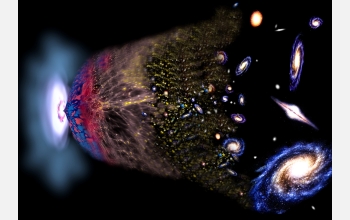Multimedia Gallery
History of the Cosmos
This artist's conception illustrates the history of the cosmos, from the big bang and the recombination epoch that created the microwave background, to the formation of galactic superclusters and galaxies themselves. The dramatic flaring at right emphasizes that the universe's expansion currently is speeding up.
Observations by the High-z Supernova (High-Z SN) search team, described by Robert Kirshner, hint that we live in a "stop and go" universe whose expansion slowed under the influence of gravity before accelerating again due to an unexplained dark energy.
The High-Z SN search team is an international group of astronomers interested in using type Ia supernovae to trace the expansion of the universe from the present day to nine billion years in the past. In 1998, the High-Z SN team, along with the Supernova Cosmology Project team, uncovered evidence that the universe is accelerating as it expands. Science magazine listed the discovery as one of the top 10 scientific breakthroughs that year. (Year of image: 2003)
Credit: David A. Aguilar/Harvard-Smithsonian Center for Astrophysics
See other images like this on your iPhone or iPad download NSF Science Zone on the Apple App Store.
Images and other media in the National Science Foundation Multimedia Gallery are available for use in print and electronic material by NSF employees, members of the media, university staff, teachers and the general public. All media in the gallery are intended for personal, educational and nonprofit/non-commercial use only.
Images credited to the National Science Foundation, a federal agency, are in the public domain. The images were created by employees of the United States Government as part of their official duties or prepared by contractors as "works for hire" for NSF. You may freely use NSF-credited images and, at your discretion, credit NSF with a "Courtesy: National Science Foundation" notation.
Additional information about general usage can be found in Conditions.
Also Available:
Download the high-resolution JPG version of the image. (3 MB)
Use your mouse to right-click (Mac users may need to Ctrl-click) the link above and choose the option that will save the file or target to your computer.

